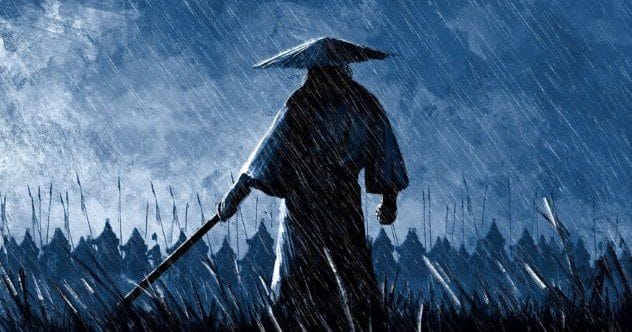Step into the shadows of feudal Japan, where warriors known as samurai carved a legendary path. But what happened when a samurai lost their master? They became ronin – masterless, adrift, and often misunderstood. These figures, a blend of tragedy and rebellion, hold a unique place in Japan’s history. Get ready to uncover 10 surprising facts about these legendary warriors, peeling back the layers of myth to reveal the truth about the ronin.
10 The True Meaning of the Term “Ronin”
What does “ronin” actually mean? The term comes from Japanese words that paint a clear picture: “floating man” or “wandering man.” Some even say “wave man.” This is because people saw ronin as having no set path, like a wave carried by the ocean’s currents.
At first, “ronin” wasn’t just for samurai. It appeared way back in Japan’s Nara (710–794) and Heian (794–1185) times. Then, it meant serfs who had run away from their masters. Later, during the Kamakura period (1185–1333), the word became well-known across Japan. It was used for samurai who didn’t follow old traditions and had to roam from one place to another.
Often, other samurai and lords used the “ronin” label to look down on warriors who rebelled. This was probably a way to stop others from disobeying. Because many ronin had to take any job they could find, like being a bodyguard or hired sword, the word also got linked to “mercenaries.” Some even became pirates or secret killers who broke the law.
9 Ronin Were Born Due to Cultural Shifts
The rise of ronin became especially noticeable during Japan’s Edo period (1600–1878). Big political changes pushed many samurai into becoming ronin. Before this, in the Sengoku period, things were different. If a samurai’s lord died in battle, the Bushido Code allowed them to find a new master.
Warriors were always needed during the Sengoku period, so masterless samurai usually had many job options. The ritual suicide known as seppuku (often called “hara-kiri” in Western countries) wasn’t as common for samurai then.
But as the Edo period began, Japan’s leader, Toyotomi Hideyoshi, brought peace to the country with the help of the shogunate. This peace meant fewer warriors were needed. The Tokugawa shogunate, which ruled during this time, started to enforce very strict rules for samurai. They could no longer find a new master if their current one died. They also couldn’t start a new job or trade. This left them with very few choices, other than seppuku. So, many samurai chose the difficult path of the ronin, forced to survive using their sword skills.
8 Ronin Were No Longer Considered Samurai
In feudal Japan, the shogunate set up a rigid social ladder. Samurai were important members of this military system. They served lords called daimyo, who in turn served the shogun. The shogun served the emperor. Ronin, however, had no masters. This meant they were outside this special group.
The samurai class often looked down on ronin and wanted nothing to do with them. Sometimes, people called ronin “rogue samurai,” but this was mostly a term used by common folks. By definition, “samurai” means “those who serve.” Since ronin didn’t have a master (daimyo) to serve, they couldn’t officially hold the title of samurai anymore.
7 Ronin Were Deemed Lower Class
From the 12th to the 19th centuries, Japan had a class system with four main levels. Ronin were seen as lower class than samurai. They were often grouped with farmers and peasants. This was because they no longer worked for a lord and didn’t have the same special rights as employed samurai.
The strict social order of feudal Japan viewed ronin as a disgrace. They were considered men who had failed their duty to their lord and their country. You could compare it to being dishonorably kicked out of the army today, but being a ronin was much harder.
A samurai’s main job was to serve their daimyo. Without a master, they were seen as without honor or purpose. The strict Bushido codes imposed by the Tokugawa shogunate made things even tougher. Because of these rules and lack of options, many ronin sadly turned to crime. It’s hard to blame them, as they were often victims of a system that didn’t support them.
6 Ronin Shattered Japanese Tradition
Ronin weren’t just masterless warriors; they were also seen as rebels. They weren’t tied to the same rules as traditional samurai. Ronin didn’t have to follow the samurai code of honor, known as Bushido. This code told samurai how to live and die. Since ronin were no longer considered samurai, they didn’t have to strictly practice the eight virtues of Bushido, though surely some still tried to live by them.
A key tradition ronin broke was seppuku. When a samurai’s master died, Bushido said the warrior should perform seppuku or face great shame. Seppuku was a ritual suicide, seen as an honorable way to die. It involved stabbing and cutting open the stomach with a short blade called a tanto, then turning the knife upwards to ensure death.
However, ronin chose not to follow this tradition – that’s why they became ronin in the first place. Most samurai would perform seppuku if they couldn’t find a new master. Others took their own lives to honor their dead masters, even if they could have found new work. Ronin chose a different path.
5 Ronin Had a Notorious Reputation
The shogunate, or military government, thought of ronin as unpredictable and dangerous people. They were often linked with crime and violence. This was because many ronin had to turn to illegal activities just to survive. Some warriors who wanted to keep some of their lost honor became mercenaries or bodyguards for wealthy people. Unfortunately, many other ronin ended up in lives of theft, violence, and gang activity. Their image became particularly bad during the Edo period.
Despite their fallen status, ronin were known for being excellent swordsmen. This was thanks to their past lives and training as samurai. Like samurai, they carried two swords. But they also knew how to use many other weapons, such as long staffs called bo staffs and bows and arrows. This made them some of the deadliest fighters available for hire.
4 Ronin Often Rebelled against Authority
There were many times when groups of ronin took up their weapons against the shogunate and other authorities. The most famous example is the story of the 47 Ronin, also known as the Akō Incident. In 1703, this group of masterless samurai avenged their daimyo’s death by killing a court official named Kira Yoshinaka. This act of samurai loyalty and revenge became a very popular story, later turned into famous plays and movies.
Another well-known case is the Keian Uprising in 1651. A group of ronin planned to force the Tokugawa Shogunate to treat ronin with more respect. Their plan involved setting fires in the city of Edo (now Tokyo) and attacking Edo castle. Although this revolt ultimately failed, it did make the shogunate ease some of its strict rules for ronin, and for all samurai as well.
3 Some Samurai Desired to Become Ronin
While many looked down on becoming a ronin, some samurai actually wanted that lifestyle. They thought they could live a freer and more truly honorable life without being tied down by the changed Bushido Code. During the 19th century, as the 260-year rule of the Tokugawa shogunate was coming to an end, the ronin path became appealing to struggling samurai.
Many of these ronin wanted to remove Western influences from Japan and bring the imperial family back as the rightful rulers of the country. In an interesting turn of events, some samurai willingly left their lords to become ronin. It’s believed that these ronin played a part in inspiring the Meiji Restoration. This was a major event that brought an end to the Tokugawa Shogunate and the Edo period in 1867.
2 A Ronin Invented the Modern-Day Haiku
Believe it or not, a ronin played a key role in creating a famous form of Japanese poetry! During the Edo period, a new style of poetry called hokku emerged from an older style called renga. A ronin named Matsuo Basho made this new style popular. His poems were quite different from traditional Japanese poetry of the time. He wasn’t a fan of the current styles known as haikai and renga.
Instead, Basho started to experiment with poetry, writing hokku with a specific 17-syllable structure. He called his unique approach “Shofu” or “Basho style.” His work is seen as one of the most important inspirations for the haiku. Basho is largely credited with making hokku a separate form from renga poetry. In fact, his poem “An Old Pond!” is often considered the oldest example of what we now know as the modern-day haiku.
1 Ronin Evolved over Time
As Japan moved away from its feudal system, the roles of both ronin and samurai changed significantly. During the Meiji period (starting in 1868), Japan went through a massive process of modernization. A major part of this was the official end of the samurai class in 1876. Because of this huge shift, the warrior class had to adapt, just like a_new_page_link_the rest of Japan.
Historians describe this change as a move from being a “feudal vassal to patrimonial bureaucrat.” Essentially, these former warriors had to find new places in society. The Meiji Restoration led to many ex-samurai joining the new national military. Others became teachers, farmers, or business owners. This period of change brought new opportunities for ronin and helped to reshape their place in Japanese society.
The story of the ronin is a complex tapestry woven with threads of honor, desperation, rebellion, and surprising creativity. Far from being simple outcasts, these masterless samurai shaped Japan’s culture and history in ways that still echo today. Their journey from revered warriors to wandering figures, and sometimes back to heroes, reminds us that history is often more nuanced than it first appears.
What fact about the ronin did you find most captivating? Or do you know another intriguing detail? Share your thoughts and join the conversation in the comments below!










